New WDFW Biodiversity Funding Package Comes With Huge Caveat
Washington legislators handed WDFW $23 million for new biodiversity work in the recently passed 2023-25 state operating budget, but they also snuck in an unsettling proviso requiring the agency’s governance, mandate and more to be reviewed and possibly reformed, enraging sportsmen’s groups that had worked in support of the greater package.

WDFW had been angling for some $47 million from the General Fund over the coming two years to significantly boost its efforts to restore and recover at-risk species at lawmakers’ and the public’s requests, and to that end Director Kelly Susewind and Fish and Wildlife Commission Chair Barbara Baker made a pitch in a February Seattle Times op-ed in support of what they billed as their “highest priority for new funding.”
They got half that amount, a big boost to be sure, but it came with state pols’ unexpected post-Easter egg, which smells worse and worse and worse the longer you look at it.
The proviso, designated 32(b) on page 430 of the passed budget, appears to have been tacked into the WDFW’s operating budget somewhere in the latter stages of the session – it wasn’t in initial spending proposals from the Democrat-controlled Senate and House, nor budget bills that were passed off the floor of either chamber beforehand.
It centers on a $300,000 grant to a university think tank to review WDFW’s governance structure, funding model, mandate, the commission, the “influence on the department by special interest groups,” how it uses “science and social values in its decision making,” complies with state laws such as SEPA, “(fulfills) its obligations as the trustee of state fish and wildlife on behalf of all current and future Washingtonians,” and more.
“This is a big deal,” said a prominent member of the Washington fishing and hunting world.
There’s a faint whiff of Rep. Joe Fitzgibbon’s HB 2027, one of a series of WDFW- and commission-related bills that were introduced early last year, indicating building interest by the powers that be in Olympia to alter the mission of the agency and its overseers. The Central Sound Democrat’s bill faded away, as did the others, as Governor Jay Inslee’s office began further remaking the citizen panel with a host of new appointees that continued into early this year (all nine were recently confirmed by the full senate, some by narrower margins than others, but indicative of general political buy-in of the members).
Last summer Inslee also hired a new senior natural resources policy advisor known for stumping for fish and wildlife agency reformation, and outside state government there has been a steady drumbeat for deeper reforms among extremist quarters like Washington Wildlife First, which held an organizing conference on the matter last fall with a senior Senate budget writer, before abruptly deleting the agenda after I reported on it.
To a degree, reformists have been foiled by WDFW and the commission’s twin mandate, set in stone by the legislature to conserve the state’s fish and wildlife and maximize angling and hunting opportunities. But earlier this month, WWF, Wild Fish Conservancy and 48 of their closest friends in the highly litigious animal-rights world sent state budget writers Sen. Christine Rolfes and Rep. Timm Ormsby a request to “earmark $300,000” of that biodiversity package for a “WDFW Accountability and Reform Study,” which they wanted to be performed by the Washington State Institute for Public Policy, run by Evergreen State College.
In a message to supporters earlier this month, WWF billed it as the “WDFW Reform Provision,” telling them they had “one last opportunity to make progress on state wildlife management reform this legislative session” and urged them to contact their electeds about the provision “setting out a roadmap for long-term agency change.”
Ultimately, lawmakers instead chose Washington State University and the University of Washington’s Ruckelhaus Center for the review, but they folded much of the draft language WWF et al floated straight into the final budget proviso – except with an even firmer imperative for the center to come up with recommended changes.
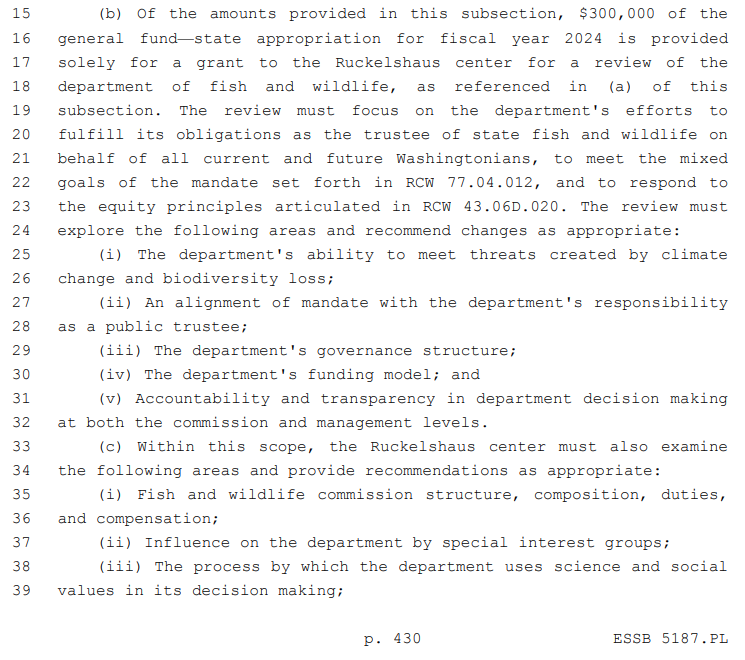
This afternoon, members of two Washington sportsmen’s organizations are expressing shock at the 32(b) proviso, as well as outrage about what feels like a backstabbing after they’d signed their names in support of WDFW’s biodiversity package, meant to help myriad critter populations that are struggling these days and desperately need help but unfortunately don’t have assigned funding sources like pursued fish and game.
“Backcountry Hunters & Anglers, among other sportsmen conservation groups, advocated in support of the original biodiversity funding proviso. We strongly believe that biodiversity initiatives benefit the concept of One Health Ecosystems, and the game species that depend on them,” said Dan Wilson, secretary of BHA’s Washington Chapter. “It is beyond disheartening that the efforts of so many were co-opted by a fringe element that seeks to undermine the Department of Fish and Wildlife and its people through a reform movement targeting the most successful model of wildlife management in the world. Beyond that, it is truly a shame that critical dollars needed for our most imperiled species are being diverted to serve the special interest agenda of myopic activists willing to go to the extreme.”
Marie Neumiller, who heads up the Inland Northwest Wildlife Council, was even more blunt in her personal assessment.
“Whoever wrote that subsection burned a lot of bridges with their addition,” she stated.
Neumiller said if she’d seen the 32(b) language in the proviso, she would have not have advised signing her organization up in support of the biodiversity funding request.
“This may prove to have a broad impact on overall cooperative efforts for wildlife management in our state,” she warned. “It might be hard for some to trust our state’s leadership knowing that something like this could be slipped in at the eleventh hour without public outreach or consultation.”
True, Inslee could always veto the proviso before he signs the budget into law, as he’s done with others directed at WDFW in the past, but that seems as likely as him permitting a few coal plants anytime soon.
As it stands, UW and WSU’s Ruckelhaus Center “must provide options for making changes to the department’s mandate and governance structure as deemed necessary to improve the department’s ability to function as a trustee for state fish and wildlife,” according to the operating budget’s language, and its report is due back to the legislature by June 30, 2024.
We can cross our fingers the review is performed in a professional, unbiased way befitting two respected state universities, but this feels basically like the culmination of Chapter 1 of all that I’ve been reporting on WDFW and the commission since early 2020 – the arrival of Fred Koontz and Lorna Smith, spring black bear hunting, Blue Mountains elk, draft conservation policy, more commissioners, what have you – confirming that big moves are afoot and Evergreen State sportsmen as well as national fishing and hunting organization need to be paying closer attention to what’s going on in Washington. Now comes Chapter 2.
As for the lion’s share of that overall $23 million WDFW biodiversity package, funding will go toward elements such as “habitat protection and restoration, technical assistance for growth management planning, fish passage improvements, conservation education, and scientific research for species and ecosystem protection,” per a budget statement.
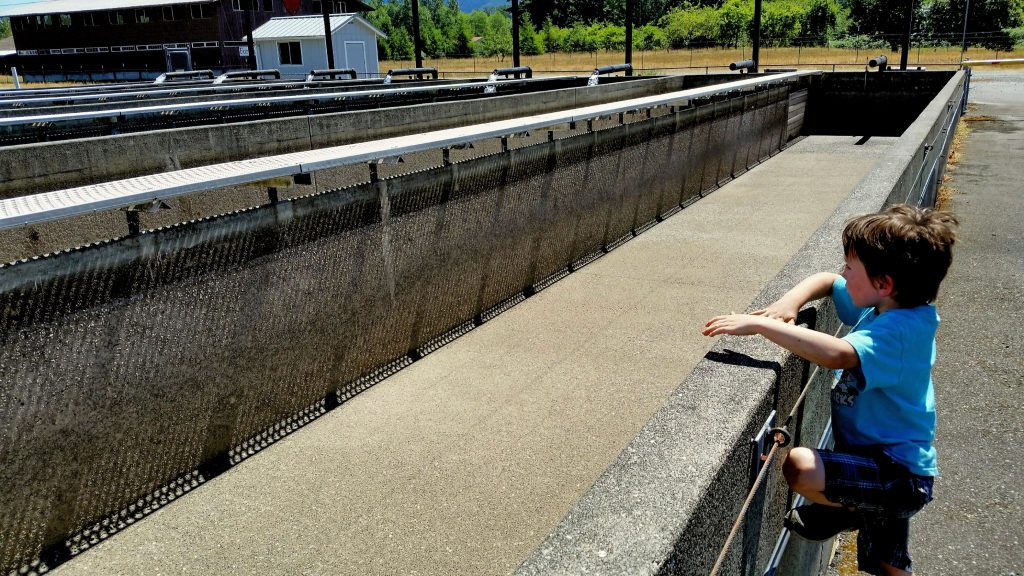
CAPITAL BUDGET
Among the most disappointing budget news is that there’s no new money for WDFW’s Deschutes Watershed Center, a long-planned hatchery and educational facility to be built near the state capitol for the rearing of nearly 4 million fall Chinook. Sportfishing organizations had been hoping to finally get going on the project, and north of $11 million had been included in proposals from the Governor’s Office and Senate, but the House offered no new money, and then along came last week’s suspiciously timed WWF lawsuit about land recently acquired for the hatchery and other WDFW salmon production plans. Whether there is any actual relation between the lawsuit and the derailing of the project for at least another two years is unclear, but it will only serve to plaster WWF’s reputation.
On the flip side, there is $54 million for other WDFW hatchery operations and upgrades, including $17.2 million to replace intakes and ponds at Wallace, $16.8 million, $11.5 million, $2.7 and $2.1 million to renovate Spokane, Naselle, Beaver Creek and Soos Creek, as well as $1.18 million and $950,000 to modify or expand Sol Duc and Palmer Ponds on the Green for southern resident killer whale forage efforts. Most of Washington’s salmonid-based fisheries are largely fueled by hatcheries.
There’s also just over $2 million in pass-through hatchery funding for the Northwest Indian Fisheries Commission and the Yakama Nation, among others, for SRKW production.
Another $44 million will go to WDFW for the Duckabush River estuary restoration project in Hood Canal, which will elevate the Highway 101 crossings and reconnect the floodplain. In related fish-and-wildlife-related capital budget expenditures, $120 million is directed to state Recreation and Conservation Office Salmon Recovery Funding Board projects, another $120 million for Washington Wildlife and Recreation Program habitat, conservation, access, riparian and other projects, $73.5 million for Puget Sound salmon restoration projects, $48.4 million for the Brian Abbott Fish Barrier Removal Board and $14 million for Thorp’s Springwood Ranch.

CASH FOR CRITTER CONTROL
Lawmakers provided over $12.1 million in WDFW’s operating budget to eradicate and control invasive European green crabs on the Washington Coast, Strait of Juan de Fuca and portions of Puget Sound. The worry is that the crabs will alter and affect nearshore ecosystems important to other marine species, as well as put the state’s important shellfish industry at risk.
Rep. Joel Kretz (R-Bodie Mountain) and the House of Representative’s proposal to move WDFW toward managing wolves at the county level when certain population benchmarks are reached didn’t make it into the final budget, but there is $780,000 over the coming two years for the agency to develop wolf-livestock conflict mitigation strategies, $260,000 for ongoing facilitation of the Wolf Advisory Group and $100,000 for damage-prevention contracts with livestock producers.
There’s $700,000 for a two-year “demonstration project” on Lake Washington to see if suppressing “nonnative species and northern pike minnow (sic)” improves the survival of Chinook, coho and sockeye smolts. In recent years, state and tribal crews have been assessing populations of spinyray species on the big metro lake and figuring out where young salmonids are most vulnerable to predation. Meanwhile, the American shad population there appears to be suddenly taking off, compounding and complicating things.
And lawmakers set aside $940,000 over the next two years to expand ongoing seal and sea lion diet studies in Puget Sound, the Strait of Juan de Fuca, Hood Canal and other inside waters, with an eye toward “(identifying) nonlethal management actions to deter them from preying on salmon and steelhead.”
Saltwater anglers who’ve had harbor seals steal fish off their line and/or recall the saga of Hershel and the Ballard Locks will want more direct action, but in asking for their support, WDFW honchoes last month pitched getting behind the proviso because ”You’re not going to get an exemption to the (federal) Marine Mammal Protection Act unless you bring a lot of science.”
Meanwhile, another $3.5 million will go toward installation of devices at the Hood Canal Bridge to reduce steelhead smolt mortality due to harbor seals there.

COLUMBIA RIVER PINNIPED REMOVALS, FISHERY PERMITTING
Columbia anglers will be happy to see two items.
With this spring’s huge surge of sea lions into the system to prey on the bounty of smelt, salmon, sturgeon and outmigrating smolts, lawmakers contributed $1.5 million “to reduce pinniped predation by increasing lethal removal of sea lions in the Columbia River.” The stated baseline goal is to increase prey abundance for southern resident killer whales, but several years ago the Northwest states and tribes received federal permission for more widespread authority to euthanize the marine mammals and create “safe zones” for salmon, steelhead and other fish, but they need additional funding to build trapping stations large enough to handle Steller sea lions.
The other great Columbia news is that WDFW was budgeted just under $1.4 million to hire more staffers to complete or update a number of fisheries management and evaluation plans, or FMEPs, that otherwise could be the subject of lawsuits and potential shutdowns – and not just salmon and steelhead fisheries, but trout, walleye, bass, you name it in the basin’s anadromous zone.
“Trout Unlimited is glad to see state legislative funding provided for WDFW to meet Federal ESA permitting requirements for fisheries in Columbia River Basin tributaries,” said Jonathan Stumpf of TU. “Completing these permits is critical to ensure Washington’s fisheries are meeting legal requirements and to better understand the impacts of our fisheries on ESA listed species. Along with meeting much-needed conservation goals, this funding could also give the agency the ability, where possible, to potentially expand or permit new fisheries within the Basin in the future.”
That’s a reference to Lower Columbia coho and Methow and Touchet Rivers spring Chinook, respectively.
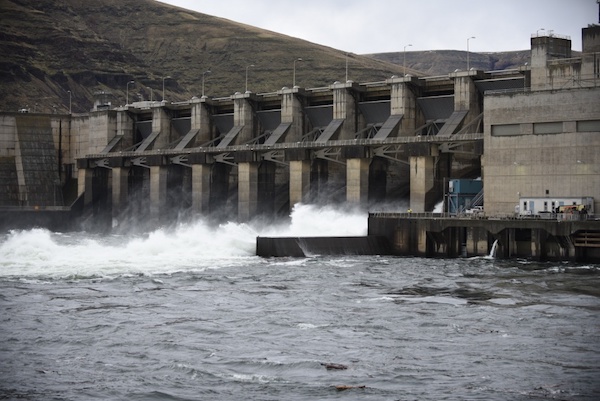
LOWER SNAKE RIVER DAMS
Lower Snake dam breaching advocates cheered inclusion of a combined $7.5 million to analyze shifting the remaining barge traffic using the river onto roads and rail lines instead, come up with a power transition plan and figure out how to keep irrigating 53,000 acres of cropland after returns to more natural flows, essentially a follow-through on Senator Patty Murray and Governor Inslee’s position last year that the benefits of removing the four in Southeast Washington must be sorted out before sundering the dams.
Congress would need to also sign-off, but breaching is considered one of the top ways to head off extinction of some Idaho salmon and steelhead stocks. The dams represent the single largest source of freshwater mortality for wild Chinook smolts, accounting for an estimated 42-plus percent of deaths.
“Governor Inslee and the Legislature recognized the urgency for salmon, and responded with a path forward that will modernize the benefits from the river and provide the best hope for salmon dependant communities and orca,” said Liz Hamilton, executive director of the Northwest Sportfishing Industry Association in a press release.
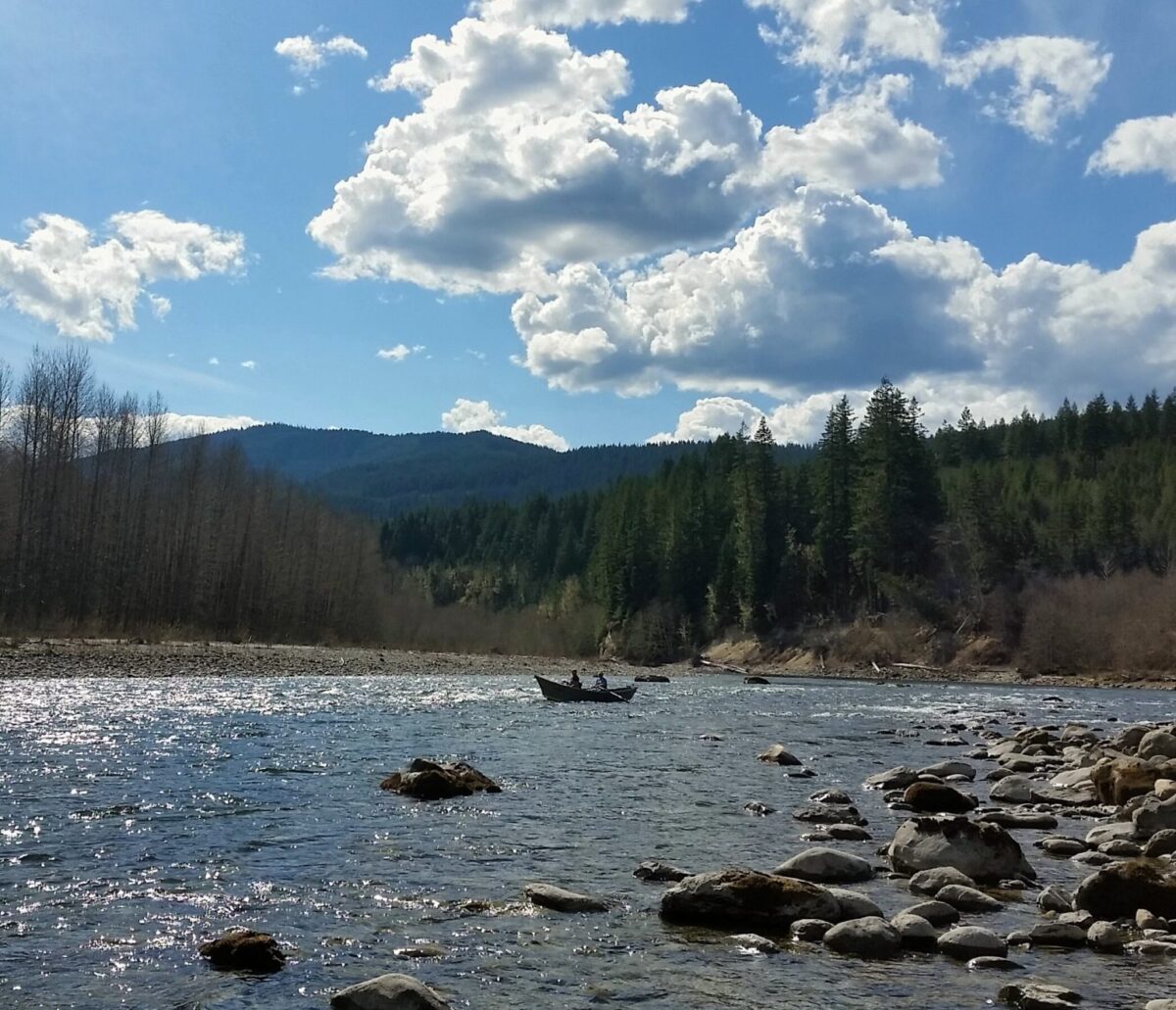
PUGET SOUND-CENTRIC PROVISOS
TU’s Stumpf was also pleased to see the legislature’s continued funding – $1.6 million the next two years – for WDFW’s Quicksilver Portfolio, which aims to provide a diversity of steelhead angling options across Pugetropolis.
“These resources support critical population monitoring and popular fisheries, such as the beloved Skagit-Sauk fishery anglers are enjoying this spring,” he noted.
And because salmon and shellfish scofflaws never sleep, lawmakers approved $2.7 million for phase two of a 15-officer increase to police recreational and commercial fisheries in the region and on the coast, and they threw in an additional two game wardens for marine waters specifically, plus one-time funding for a new patrol boat.
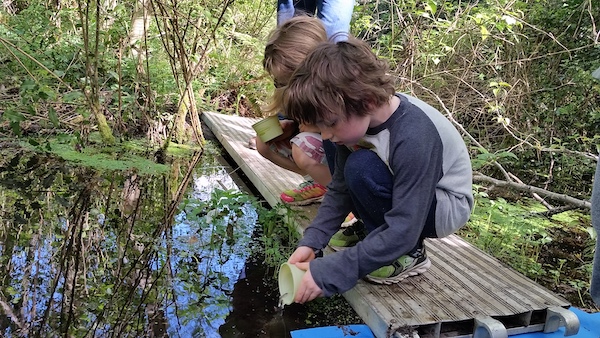
QUICK HITS
Lawmakers also allocated:
• $10 million to deal with maintenance backlogs on WDFW lands and access sites;
• $5.2 million to the Department of Ecology to set up a program to monitor the compounds coming off vehicle tires, running off into streams and killing coho;
• $3 million in pass-through funding to Upper Columbia tribes in support of reintroduction of Chinook above Chief Joe and Grand Coulee Dams;
• $2.35 million for shrubsteppe restoration on public lands and those of willing property owners;
• Just under $2 million to continue assessing riparian areas;
• $915,000 for game warden body cameras;
• Just under $1.9 million to patch a federal shortfall and fund operations at Toutle and Skamania Hatcheries, which rear a mix of fall Chinook, coho and steelhead;
• $1 million to evaluate white and green sturgeon abundance on the coast and Puget Sound and how interrelated they are to Columbia and Fraser fish, as well as monitor eulachon smelt;
• $645,000 to survey for wildlife disease risks and write management plans for them;
• $500,000 in grants to Lower Columbia commercial fishermen to modify gear to participate in emerging fisheries such as purse and beach seines, and tangle and pound nets.
* And $500,000 for rearing salmon eggs at elementary schools and having kids release them into local waters.
Correction, 8:43 p.m., April 27, 2023: Grant funding for Lower Columbia commercial fishermen to modify their gear was more broad than originally reported in the second to last section of the above roundup. The legislature made grants available not just for pound nets, but beach seines, purse seines and tangle nets as that particular proviso was moved out of the Recreation and Conservation Office’s budget to WDFW’s.
